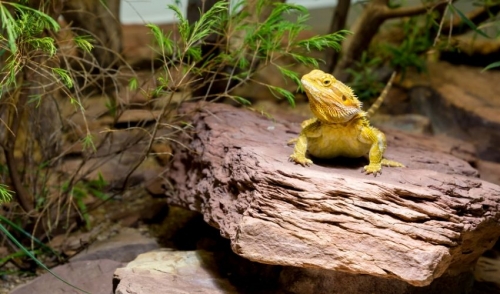10 Symptoms of Diabetes in Dogs
Diabetes can be a challenging condition to manage, especially in pets that cannot verbally communicate how they feel. Recognizing the symptoms of diabetes in...

From frogs to snakes and everything in between, building the ideal reptile habitat is a labor of love for exotic pet enthusiasts. Blue Fish Aquariums has put together the ultimate cheat sheet for the housing reptiles and amphibians. Learn more about which enclosure is right for your pet and how to create a healthy, stimulating environment.
A good rule of thumb when selecting the right terrarium is to increase the dimensions by half an inch for each additional animal. An enclosure should be large enough for your pet to move comfortably, thermoregulate, forage, and sun itself. Many reptiles can reach an impressive size as adults. When projecting how much space they will need, it's important to take tail measurement into account as well.
You'll also want to consider the natural habitat of your miniature dinosaur. While snakes and frogs may spend the majority of their time lounging under the heat lamp or under a comfortable pile of substrate, lizards are active animals that love to climb. Tree lizards require vertical terrariums, while other species such as desert lizards do best with lots of vertical space.
Keeping a variety of plants and animal species? Meet in the middle with a cubic terrarium!
Environmental regularity is highly important when it comes to reptile and amphibian habitats. Be sure to research species specific requirements before adding a new scaly friend to your household.
Light, temperature, and moisture are the three main factors every reptile needs. Most frogs and lizards thrive around 70 to 90 percent humidity, while species like corn snakes prefer 30 to 50 percent. Heat is fairly constant, with the majority of reptiles doing well in temperatures between 70 to 85 degrees, with basking areas that reach around 90 to 100. Misting systems may be necessary as well, especially for frogs and other amphibians.
You'll also want to take light into account. A UV bulb is essential and can adjusted to suit species specific activity requirements. Consider whether your new pet is nocturnal or diurnal when setting up their ideal habitat.
Once you've secured the essentials, it's time to decorate your enclosure with logs, trees, plants, rocks, and substrate. Go all out with fun designs or stick to a creative theme like a western desert or a tropical island. Your pet will thank you for providing enrichment, security, and plenty of places to hide along with a fantastic sense of style.
Contact the experts for more great tips on fish, frogs, reptiles, snakes and other wild things.
We are constantly adding new specials to our site. Be sure to check back often!
We currently do not have any events scheduled.

Diabetes can be a challenging condition to manage, especially in pets that cannot verbally communicate how they feel. Recognizing the symptoms of diabetes in...
Comments